In the last few years, the team at Ironstone Homes has received a surge of inquiries about ADU housing, “dawdy homes”, and of course, the many regulations related to this emerging approach to adding smaller permanent residences in Pennsylvania. For good reason! In-law quarters or ADUs are a great way to create functional and efficient living space for families and friends . . . if you can get them across the finish line in your municipality.
This guide will give you an overview of ADU housing and some basics on the process of building one on YOUR property.
What is ADU Housing?
An Accessory Dwelling Unit (ADU) is an independent residential unit generally “in addition” to existing structures. Essentially, that means it’s a smaller living space built onto or next to an existing home. Typically, an ADU includes a kitchen, living area, and a separate entrance, making it a fully functional living space within the property.
In the past few years, ADUs have seen a surge in popularity across the United States, including Pennsylvania, due to rising home prices, high interest rates, and low availability of affordable housing. These factors, plus a rising desire to age in place among the baby boomer population, are forcing property owners to get creative with their living arrangements, often by housing multiple generations in the same residence.
ADUs provide a solution. They can be used to house family members like aging parents or adult children, allowing them to live nearby while maintaining their independence. Additionally, ADUs can serve as rental units, providing homeowners with an opportunity to generate extra income to offset mortgage costs or fund other expenses.
ADU is a newer term, and many in our area will be more familiar with the term in-law quarters or even dawdy haus / house.
Types of Accessory Dwelling Units
Accessory Dwelling Units come in a variety of forms to suit different needs and property layouts. The three main types of ADUs are internal, attached, and detached units.

Detached
Detached ADUs, also known as backyard cottages, a dawdy house, or tiny houses, are standalone structures located on the same lot as the main house. These units often provide the highest increase in property value due to the additional square footage they contribute for appraisal purposes. Detached ADUs offer maximum privacy and can be customized to serve as a guest house, home office, or rental unit.
Attached
Attached ADUs connect to the main house, usually through a shared wall or by converting structures like garages. Garage conversions, a common form of attached ADUs, offer a cost-effective way to create additional living space without major structural changes using an existing accessory structure. Although generally smaller than detached units, they still add considerable value and functionality to the property.
Internal
Internal ADUs repurpose existing spaces within the primary residence, like basements or attics. These units are often the most economical, typically requiring less construction work and fewer permits. They are ideal for accommodating family members or providing rental housing within the home’s existing footprint.
The Obvious Benefits of ADU Housing
Accessory Dwelling Units offer a range of benefits that make them an attractive option in housing choices for homeowners. One of the key advantages is their flexibility in providing additional living space for various family arrangements, including a principal dwelling. Whether it’s for in-law quarters, housing for adult children, or creating a multi-generational home, ADUs serve as a practical solution to meet diverse housing needs.
Financially, ADUs can be a significant asset. Renting out these units generates additional income, helping offset construction costs and contributing to household finances.
Moreover, ADUs enhance local housing and affordability by providing an alternative to costly assisted living facilities for elderly family members! They allow seniors to maintain independence while staying close to loved ones. This arrangement fosters family connections and offers a cost-effective housing option as home prices rise.
Costs Involved in Building an ADU
The cost of constructing an ADU varies significantly depending on the type, location, and size of the unit.
Costs generally range from $80,000 to $200,000 for conversions of a detached garage or similar, and $250,000 up for detached units. Factors such as materials, labor, design complexity, and location can cause fluctuations.
Permitting costs are another critical consideration when planning an ADU project. Building permits in Pennsylvania can range from $1,350 and up, though this can vary widely depending on local building department requirements and zoning ordnances.
Homeowners will also need to ensure their existing sewage systems can support a new ADU, which may require upgrades before the project can be completed. Proper planning and consultation with experienced contractors like Ironstone Homes can help mitigate these risks and keep the project on budget. We’ve been helping homeowners budget for and navigates these nuances for nearly twenty years.
Financing Options for ADU Construction
Homeowners have a couple of options at their disposal, as ADUs aren’t totally foreign to lenders and can even increase property value when done right.
Financing options include renovation loans, refinancing, home equity loans (or lines of credit), and of course using cash-on-hand.
Home equity loans allow homeowners to borrow against the equity they have built up in their existing property. These loans typically come with fixed interest rates, providing predictable monthly payments throughout the loan term. This option is great for those who have significant equity and prefer stable financing terms.
Home equity lines of credit (HELOCs) offer a flexible approach, allowing homeowners to withdraw funds as needed for their ADU project. This flexibility is useful for managing varying costs during construction.
We’d be happy to chat with you about the best way to plan for and fund your ADU project.
Unfortunately, Local Zoning and Permitting Requirements for ADUs Can Be Complex
Navigating zoning and permitting requirements for ADUs in Pennsylvania can be complex, with different municipalities adopting various zoning regulations that either permit or restrict the development of ADUs within established neighborhoods. Homeowners need to understand these zoning regulations when considering ADU projects, as they impact the legal status and integration of ADUs within existing neighborhoods. Local zoning department laws will dictate specific size and style limitations for property owner, differing from one county to another.
Some areas have incredibly strict rules about ADUs, while other areas are very permissive. (And it’s worth mentioning that communities across Central and Southeastern PA are discussing revisions to ADU regulations.)
Homeowners must understand local policies to ensure their project complies with legal requirements. Obtaining building permits for ADUs involves submitting detailed plans and getting local approvals and inspections. This can be time-consuming, requiring meticulous documentation to meet the local ordinances and standards (here’s an example from a Lancaster County municipality). Using experienced contractors, like the team at Ironstone, can streamline this phase of building an ADU.
Building Codes, Standards, and Permits for ADUs
Every ADU built in Pennsylvania must be built to local and state codes to be legally habitable. ADUs must provide essential independent living amenities, such as sleeping quarters, housekeeping facilities, and lavatory provisions, ensuring functionality as a complete living space.
Pennsylvania’s residential code also specifies requirements for thermal insulation and HVAC systems so that ADUs are energy-efficient and comfortable.
Tiny House Laws and ADU Regulations in Pennsylvania
Tiny houses are a trendy ADU option among younger generations navigating the housing market. Unfortunately, tiny house enthusiasts in Pennsylvania must navigate a patchwork of building code and regulations that vary by county. Before becoming tiny homeowners, you’ll need to understand these local building department rules. Here are some general guidelines to consider:
Statewide Regulations
Pennsylvania has adopted the 2018 International Building Code, which mandates that each dwelling unit must have a minimum of 120 square feet of floor area for one room, with at least 70 square feet of additional living space. This ensures that even tiny homes meet basic living standards.
County-Specific Rules
PA counties differ widely in their regulations on tiny homes. Some counties impose restrictions on the minimum square footage required for ADUs, with some counties not outlining such requirements while others mandate a minimum of 120 square feet or even 500 square feet for newly constructed dwellings.
Lancaster County is known for its more lenient regulations, allowing tiny homes to be built on wheels or a permanent foundation. This flexibility makes it a fairly attractive option for tiny home communities.
Other counties in PA are far more restrictive.
Chester County has a fairly supportive stance towards tiny homes and ADUs, providing favorable regulations and resources for interested residents. York County, on the other hand, has strict zoning regulations concerning tiny homes and ADUs, in our experience, including a minimum habitable space requirement significantly larger than typical tiny homes and prohibitions against using these units as permanent living quarters, making it a challenging environment for tiny home enthusiasts. Bucks County falls somewhere in the middle.
Homeowner Association (HOA) Covenants and ADUs
If you’re a part of a Homeowner Association (HOA), the language of your HOA covenant can significantly impact the process of building an ADU on your property. Here are some key considerations:
Size, Design, and Placement Restrictions
HOA covenants may impose limitations on the size, design, and placement of ADUs on your property. These restrictions aim to maintain the aesthetic and uniformity of the community. Even simple garage apartments may be tough to get through.
Approval Requirements
Most HOAs will require approval from the board of directors before you can construct an ADU. This approval process ensures that your project complies with community standards and guidelines.

Material and Finish Specifications
HOA covenants may even dictate the types of materials and finishes used in your ADU construction, their goal being to help maintain the visual harmony of the neighborhood.
ADUs in Pennsylvania: A Worthwhile Long-Term Investment
Considering the increasing demand for flexible housing options and the potential for generating rental income, ADUs can represent a wise investment for the future!
By adding an ADU, (and working with a competent ADU construction company) homeowners can enhance their property’s value and enjoy the benefits of additional living space and financial returns for years to come.
Navigating local building department regulations, correct permits, zoning laws, and HOA restrictions can be challenging, but with Ironstone Homes’ expertise, homeowners can confidently embark on ADU projects of all types. Our team is dedicated to helping ensure that each ADU development project meets all local requirements and is completed with the highest standards of craftsmanship.
Navigate the complexities of zoning, permitting, and building codes, with care and a construction company in Lancaster that’s done it before. Give us a call to learn more and get started.









